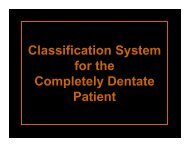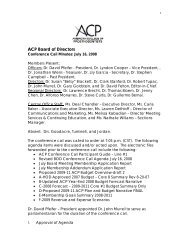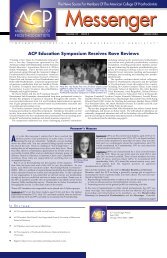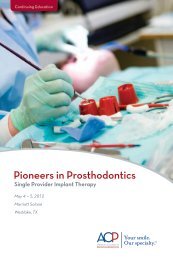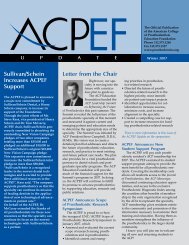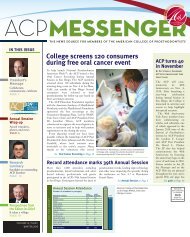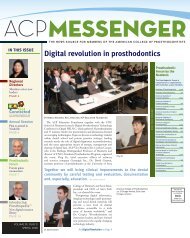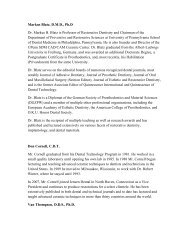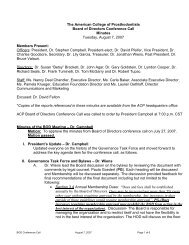PROSTHODONTICS - American College of Prosthodontists
PROSTHODONTICS - American College of Prosthodontists
PROSTHODONTICS - American College of Prosthodontists
Create successful ePaper yourself
Turn your PDF publications into a flip-book with our unique Google optimized e-Paper software.
June 2004, Volume 13, Number 2 81Table 2. Worksheet Used to Determine ClassificationClass I Class II Class III Class IVTeeth ConditionIdeal or minimally compromised—3 or less teeth in 1 sextantModerately compromised—4 or more teeth in 1 to 2 sextantsSubstantially compromised—4 or more teeth in 3 to 5 sextantsSeverely compromised—4 or more teeth, all sextantsOcclusal SchemeIdeal or minimally compromisedModerately compromised—anterior guidance intactSubstantially compromised—extensive rest/same OVDSeverely compromised—extensive rest/new OVDConditions Creating a Guarded PrognosisSevere oral manifestations <strong>of</strong> systemic diseaseMaxillomandibular dyskinesia and/or ataxiaRefractory patientxxxxxxxxxxxNote. Individual diagnostic criteria are evaluated and the appropriate box is checked. The most advanced finding determines thefinal classification.Guidelines for use <strong>of</strong> the worksheet1. Consideration <strong>of</strong> future treatment procedures must not influence the diagnostic level.2. Initial preprosthetic treatment and/or adjunctive therapy can change the initial classification level.3. If there is an esthetic concern/challenge, the classification is increased in complexity by one or more levels.4. In the presence <strong>of</strong> TMD symptoms, the classification is increased in complexity by one or more levels.5. It is assumed that the patient will receive therapy designed to achieve and maintain optimal periodontal health.6. Patients who fail to conform to the definition <strong>of</strong> completely dentate should be classified using the classification system forpartial edentulism.Guidelines for the Use <strong>of</strong> theClassification System for theCompletely Dentate PatientThe analysis <strong>of</strong> diagnostic factors will be facilitatedwith the use <strong>of</strong> a worksheet (Table 2). Aseach criterion is evaluated, a checkmark is placedin the appropriate box. In those instances in whicha patient’s diagnostic criteria overlap 2 or moreclasses, the patient is assigned to the more complexclass.The following additional guidelines should befollowed to ensure consistent application <strong>of</strong> theclassification system:4. The presence <strong>of</strong> temporomandibular disorders(TMD) symptoms raises the classification by 1or more levels in Class I and II patients.5. Periodontal health is intimately related to thediagnosis and prognosis for completely dentatepatients. For the purposes <strong>of</strong> this system, itis assumed that patients will receive therapydesigned to achieve and maintain periodontalhealth so that appropriate prosthodontic carecan be accomplished.6. Patients who fail to conform to the definition<strong>of</strong> completely dentate should be classifiedusing the classification system for partialedentulism. 61. Consideration <strong>of</strong> future treatment proceduresmust not influence the choice <strong>of</strong> diagnosticlevel.2. Initial adjunctive therapy may change the originalclassification level. Classification may needto be reassessed after existing restorations areremoved.3. Esthetic concerns or challenges raise the classificationby 1 or more levels in Class I and IIpatients (see Fig 2).Closing StatementThe classification system for the completely dentatepatient is based on the most objective criteriaavailable to facilitate uniform use <strong>of</strong> the system.It is anticipated that such standardization shouldlead to improved communications among dentalpr<strong>of</strong>essionals and third parties. This classificationsystem will serve to identify those patients mostlikely to require treatment by a specialist or a2010 CDEL Re-recognition <strong>of</strong> the Specialty Report 182 <strong>of</strong> 279



